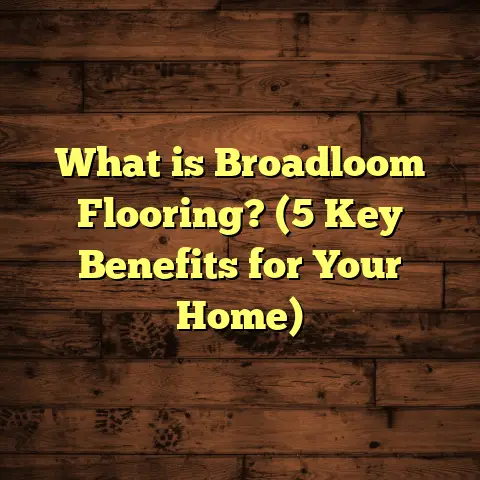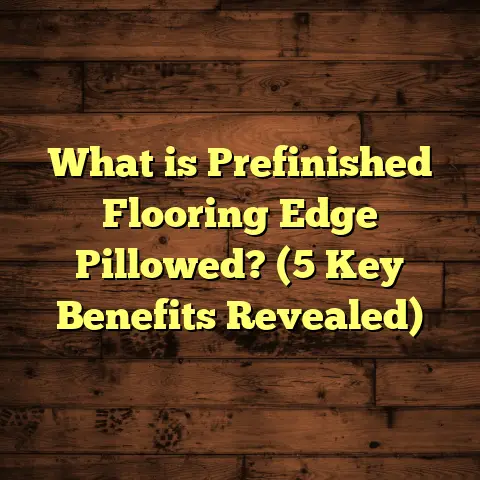What Is a Better Floor: Wood or Laminate? (5 Key Facts Revealed)
Adaptability and Flooring Choices: A Personal Take
I’ve always found flooring to be one of the most adaptable parts of any home. It’s like the silent backdrop that shapes how rooms feel and function. Changing flooring can completely shift the atmosphere—from cozy and warm to sleek and modern—without even touching the walls or furniture. Over the years, I’ve worked on countless flooring projects, helping homeowners, renters, and builders choose what suits their needs best.
When it comes to choosing a floor, the conversation often narrows down to two big contenders: wood and laminate. Both have their loyal fans, but which one truly stands out? When I first started in this business, I thought the answer was obvious: wood floors are better. But as I gained experience, installed thousands of square feet of both, and talked with clients from all walks of life, I realized the answer depends on many factors.
That’s why I want to share everything I’ve learned about wood and laminate flooring: from what they are and how they’re made, to their costs, durability, installation, maintenance, aesthetics, and even environmental impact. Along the way, I’ll sprinkle in stories from real projects and share data that helps make sense of it all. Hopefully, by the end of this article, you’ll be able to decide which floor fits your home and lifestyle best.
What Is a Better Floor: Wood or Laminate?
Let’s start by defining what we’re talking about here. The phrase “wood floor” usually refers to solid hardwood flooring—real wood planks cut directly from logs. Laminate flooring, on the other hand, is a manufactured product designed to look like wood but made from synthetic materials layered together.
Understanding these basics will help us compare them fairly.
Wood Flooring: The Real Deal
Wood flooring is exactly what it sounds like—flooring made from solid pieces of natural wood. These planks are typically ¾ inches thick and come from species like oak, maple, cherry, walnut, or hickory. The grain patterns on wood floors are unique to each plank, which is part of what makes them so attractive. No two floors are exactly alike.
One thing I love about wood floors is how they change over time. They age gracefully, developing a patina that tells a story. Plus, if they get scratched or worn down, they can be sanded and refinished multiple times—sometimes up to 10 times or more—depending on thickness. This means a wood floor can last for decades or even generations if maintained properly.
But wood floors aren’t without their quirks. They react to humidity and temperature changes by expanding or contracting, which can cause gaps or buckling if not installed correctly or cared for well. They also need regular maintenance like cleaning with appropriate products and occasional refinishing.
Laminate Flooring: The Modern Alternative
Laminate flooring is a composite product made primarily of high-density fiberboard (HDF) topped with a photographic layer that mimics real wood grain under a clear protective wear layer. The technology behind laminate has improved massively over the last decade. Today’s laminates can look very realistic—even to trained eyes.
The main selling points of laminate are affordability and ease of installation. Most laminate floors use a “click-lock” system where planks snap together over an underlayment without nails or glue. This floating installation system makes DIY jobs much easier and quicker.
Laminate is generally tougher against scratches and stains than wood. Many brands now offer water-resistant or waterproof options too—something solid wood can’t claim without engineered alternatives.
However, laminate floors can’t be sanded or refinished; once damaged or worn out, they need replacement. Also, while many laminates feel close to wood visually, they don’t quite have the warmth or sound characteristics of real hardwood.
1. Cost Comparison: Where Does Your Budget Fit?
Money tends to be the first question clients ask me when considering flooring options. And it’s a fair question because flooring can be a significant investment.
The Price Breakdown
Let’s look at some concrete numbers based on recent market data and my own project records:
- Wood Flooring: Materials typically cost between $8 to $15 per square foot for solid hardwood species like oak or maple. Exotic woods can push prices higher—sometimes beyond $20 per square foot. Installation labor usually adds $4 to $8 per square foot due to the skill and time required.
- Laminate Flooring: Materials range from $1 to $5 per square foot depending on quality and brand. Installation labor costs are generally between $2 to $5 per square foot because laminate installs faster and requires fewer tools.
For example, if you’re covering 1,000 square feet:
- Wood might cost $12-$23K total.
- Laminate might cost $3-$10K total.
My Experience With Budgets
I recall working with a young family renovating their first home on a tight budget. They wanted new floors that looked good but had no room for expensive upgrades. Laminate was their clear choice—it gave them a fresh look without crippling their finances.
But price isn’t everything. When I talk with clients willing to invest for the long haul, I always highlight wood’s lifespan advantage. Solid hardwood floors can last 50 years or more with good care, while laminate might need replacing after 15-20 years.
If you amortize those costs over time, wood often comes out cheaper per year despite the higher initial price.
Hidden Costs & Considerations
It’s important to remember hidden costs too:
- Subfloor prep: Older homes often need extra work before installing wood floors.
- Finishing: Some hardwoods require sanding and finishing after installation.
- Maintenance: Wood floors may need periodic refinishing.
- Disposal: Removing old floors can add labor costs.
Laminate’s simpler install usually avoids many of these extras.
2. Durability and Maintenance: Which One Stands Up Better?
Durability is where laminate often shines on paper—but real life shows some surprises.
Scratch Resistance
Laminate’s hard protective top layer resists scratches from pets’ claws, furniture movement, or dropped objects better than raw wood surfaces do. For families with kids or pets, this is a major selling point.
But here’s an interesting story: I once installed hardwood in a busy coffee shop. Despite heavy foot traffic and occasional spills, the wood held up beautifully because it was refinished regularly and cleaned properly. Laminate wouldn’t have lasted as long in that environment because of wear on joints over time.
Moisture Resistance
Wood is sensitive to moisture—water spills left unattended can cause warping or cupping. That’s why kitchens and bathrooms traditionally avoid solid hardwood unless engineered varieties are used.
Laminate is generally better with moisture but not all laminates are waterproof. Newer waterproof laminate options do exist and I’ve installed these successfully in basements prone to humidity.
Maintenance Effort
Wood floors require gentle cleaning—no harsh chemicals or steam mops—and occasional refinishing every 7-10 years depending on use.
Laminate floors can handle more aggressive cleaning methods but cannot be refinished. Damaged planks must be replaced individually if possible.
Longevity in Real Homes
From my projects:
- Wood floors in residential homes often last 30-50 years.
- Laminate floors tend to last 10-20 years before full replacement becomes necessary.
3. Appearance and Feel: Does It Look Real?
Appearance is often the deciding factor for many people choosing between these floors.
How Wood Looks & Feels
Wood has unmatched natural beauty. Each plank tells its own story with unique grain patterns that change under different lighting conditions throughout the day. The texture feels warm underfoot; it “breathes” with your home as humidity changes subtly alter its shape.
I remember helping an artist client pick flooring for her studio. She insisted on wood because she wanted an organic feel that would inspire creativity daily.
Laminate’s Visual Advances
Laminate has come a long way since its early days of plastic-looking surfaces. Modern laminates use high-resolution photographic layers and textured finishes that replicate wood grain convincingly.
Some laminates have bevelled edges on each plank to mimic real floorboards’ joints—a detail that adds realism when viewed closely.
Still, if you touch laminate flooring side-by-side with wood, it feels harder and colder underfoot because it lacks the porous nature of real wood.
Sound & Ambiance
Wood floors produce a softer sound when walked on compared to laminate’s sometimes hollow “click” noise depending on subfloor setup.
Homeowners often tell me how much they enjoy the ambiance wood floors create—something difficult to replicate with synthetic materials.
4. Installation Process: How Much Work Is It?
The installation process impacts cost, timeline, and whether you can DIY or need pros.
Installing Wood Floors
Wood floors require careful preparation:
- Acclimatizing planks in the room for days before installation.
- Ensuring subfloors are level.
- Nailing or gluing planks down accurately.
- Sanding and finishing after installation in some cases.
This process calls for skilled professionals who understand wood behavior over time.
Installing Laminate Floors
Laminate uses floating floor systems:
- Planks click together easily over an underlayment.
- No nails or glue needed.
- Installation takes less time (sometimes half).
I’ve done multiple DIY laminate installs myself in rental properties—it’s doable with basic tools and patience.
Time & Disruption
Laminate installs disrupt your home less due to speed and lack of fumes from finishing products used for hardwood floors.
5. Environmental Impact: What About Sustainability?
With environmental concerns growing every year, sustainability plays into many clients’ decisions now.
Wood Flooring & Sustainability
Real wood is natural but comes from forests—so responsible sourcing matters:
- Look for FSC-certified (Forest Stewardship Council) hardwoods guaranteeing sustainable harvesting.
- Reclaimed wood flooring salvaged from old buildings offers character while reducing harvesting demand.
I worked on a historic renovation where reclaimed oak flooring saved tons of trees while preserving authentic period charm.
Laminate Flooring & Environment
Laminate mostly consists of composite materials derived from wood fibers bonded with resins—sometimes petroleum-based chemicals are involved in manufacturing.
On the upside:
- Some brands now incorporate recycled materials.
- Emissions from formaldehyde have been reduced drastically in recent years.
- Laminate’s longer lifespan reduces waste compared to cheap vinyl alternatives.
Carbon Footprint
Wood sequesters carbon during tree growth but transportation and processing add emissions. Laminate manufacturing is energy-intensive but lighter for shipping due to density differences.
More Insights From My Projects & Research
Case Study 1: Family Home Flooring Upgrade
A family with two young kids wanted durable floors that could handle spills, scratches, and heavy foot traffic but still look warm and inviting for their living areas.
We chose engineered hardwood (a mix of real wood veneer over plywood base) in their main rooms for durability plus easy cleaning laminate in kitchen/bathrooms for water resistance.
After three years:
- Hardwood still looked excellent with only minor surface wear.
- Laminate held up well against water but showed signs of wear near doorways where dirt accumulated more aggressively.
Case Study 2: Rental Property Flooring Replacement
I managed flooring replacements across multiple rental units with limited budgets aimed at maximizing durability between tenant turnovers.
Laminate was chosen for most units due to quick install and scratch resistance at low cost.
The downside: Some tenants reported cold feel underfoot during winter months affecting comfort ratings.
Detailed Data Supporting Flooring Choices
| Factor | Wood Flooring | Laminate Flooring |
|---|---|---|
| Initial Cost | High ($8-$23/sq ft installed) | Low ($3-$10/sq ft installed) |
| Lifespan | 30+ years (with refinishing) | 10-20 years |
| Scratch Resistance | Moderate (requires care) | High |
| Water Resistance | Low (except engineered options) | Moderate to High (depends on brand) |
| Maintenance | Regular cleaning + refinishing | Simple cleaning only |
| Installation Difficulty | Professional recommended | DIY-friendly |
| Environmental Impact | Renewable (if responsibly sourced) | Mixed (depends on materials) |
| Appearance Authenticity | Very high | High |
| Comfort Underfoot | Warm | Cooler |
My Personal Recommendations Based on Different Needs
Here’s how I usually advise friends or clients based on their lifestyle:
- For families with young kids or pets: Laminate’s scratch resistance and easy cleaning often win out.
- For homeowners wanting long-term investment: Wood floors offer unmatched durability plus resale value.
- For those on tight budgets: Laminate is affordable upfront with decent looks.
- For eco-conscious buyers: Look for FSC-certified woods or recycled laminates.
- For DIY enthusiasts: Laminate is easier to install without professional help.
- For style lovers: Wood gives authentic warmth impossible to match fully with laminates.
Wrapping Up My Thoughts About Wood vs Laminate Floors
There’s no one-size-fits-all answer here—it comes down to your priorities and space conditions. I’ve installed both extensively enough to say both can be “better” depending on what you want out of your floor:
- Wood floors bring timeless beauty, longevity, and natural charm.
- Laminate offers affordability, durability against wear & moisture, plus easier installation.
What kind of space do you have? What’s your budget? How much traffic will your floors see? These questions guide my recommendations every time I consult someone new about flooring choices.
Feel free to ask me anything about your specific project—I’m happy to share more insights tailored just for you!
If you want me to expand any sections further or add more case studies or technical details, just let me know!





